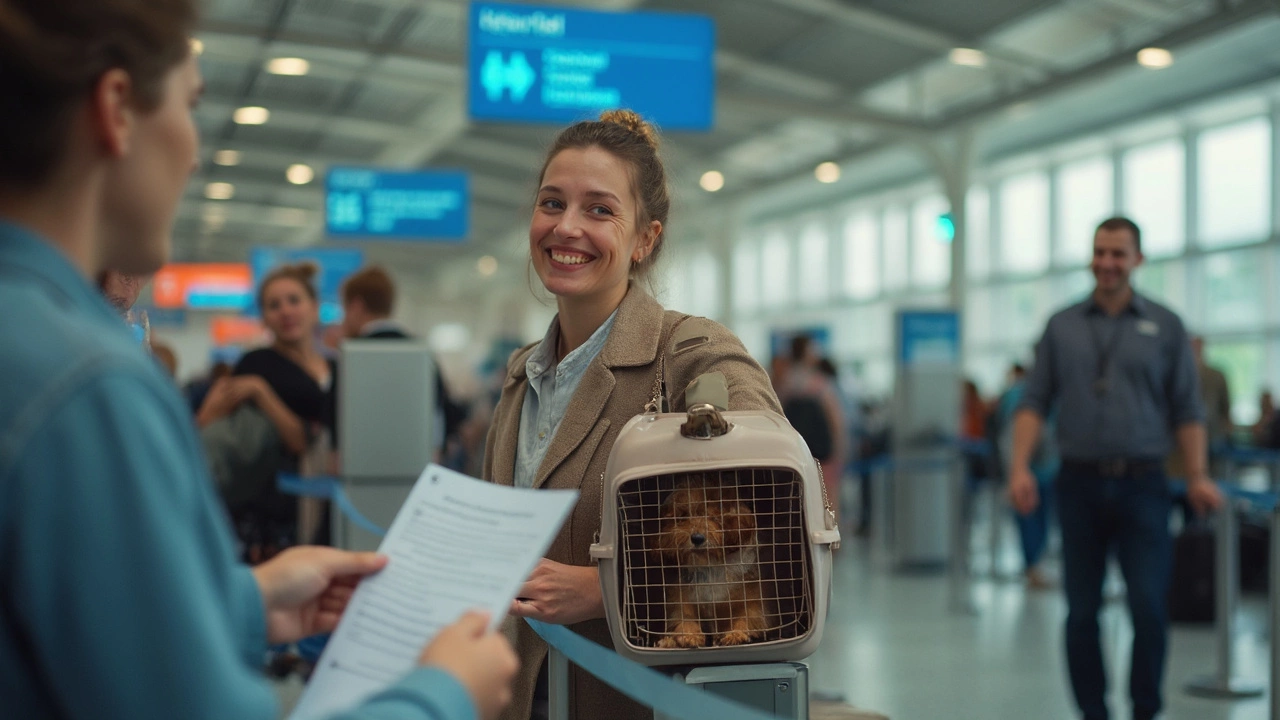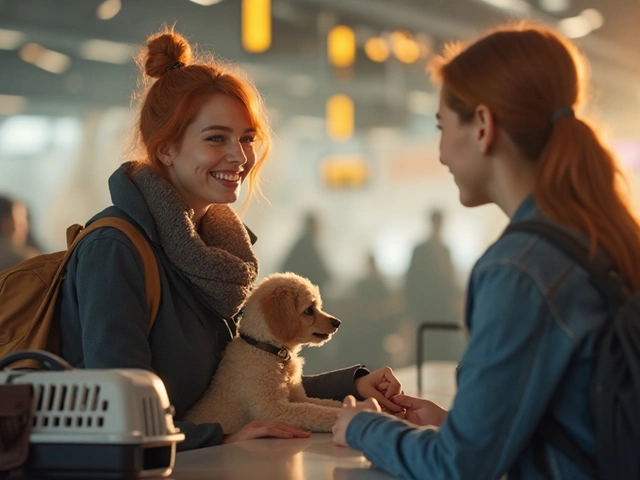Bringing your dog on a plane isn’t as wild as it sounds, but every airline sets its own rules. Not every carrier is thrilled about four-legged passengers, so knowing who says "yes" to dogs is a big deal if you want to avoid last-minute airport headaches.
Some airlines are really pet-friendly, while others act like you’re smuggling a bear onboard. If your dog’s tagging along, you need to know which airlines will wave them through—and which will politely tell you to find another ride. There’s no one-size-fits-all answer, because size, breed, and even route play roles in whether Fido flies coach or not.
Before you drop cash on tickets, get clear on each airline’s pet policy. Some only allow tiny dogs that fit under the seat. Others will check your dog as cargo, which has its own pros and cons—and some types of dogs are banned from certain flights or in certain temperatures. It might sound overwhelming, but with a bit of planning, you and your pup can have a pretty smooth trip. Let’s cut through the confusion and see which airlines say "dogs welcome."
- Big Airlines That Welcome Dogs
- Rules You Need to Know
- Cabin or Cargo: Where Does Your Dog Sit?
- International Travel with Dogs
- Tips for a Smooth Flight
Big Airlines That Welcome Dogs
If you’ve got your heart set on traveling with your pup, start by checking which big carriers make it possible. In the U.S., a handful of major airlines are well-known for letting dogs fly with you.
- Delta Air Lines lets small dogs ride in the cabin as long as they’re in a soft-sided carrier that slides under the seat. Delta’s fee is about $95 per segment. Larger dogs go in the cargo hold, but there are restrictions in summer when temperatures in the hold can get dangerous.
- American Airlines is another crowd favorite for pet owners. They allow dogs in the cabin if their carrier fits under the seat (pets and carrier can’t weigh over 20 pounds total). The fee is around $125 per segment. They also offer a cargo option for larger dogs, but brachycephalic (snub-nosed) dogs aren’t accepted due to safety issues.
- United Airlines has a similar vibe. Small dogs can go in the cabin if they fit in an approved carrier. The pet fee is $125 each way. United also runs PetSafe, a separate cargo program for big dogs, but not every destination is available for this.
- JetBlue is probably the most enthusiastic about furry travelers. Small dogs in carriers are allowed in the cabin (one per person), with a $125 fee. JetBlue even offers frequent flyer points for pets, which is pretty rare.
- Alaska Airlines not only allows small dogs in the cabin for $100 per segment—they actually get decent reviews from dog owners. They’re one of the few that also lets more than one pet in the same carrier (if they both fit comfortably).
Each of these airlines has their own quirks and restrictions, so double-check size and breed rules before booking. Some routes don’t allow pets due to international laws or aircraft type. But if you’re flying in the U.S., these are the airlines most likely to say yes to your dog.
Rules You Need to Know
If you want your dog on board, you have to play by the airline’s rules. Every carrier is different, but some things show up on pretty much every dog policy. Skip a step and you might get turned away at the gate, with your pup looking confused and your trip plans shredded.
First up, check your dog's size and carrier. Most airlines only let small dogs in the cabin. You’ll need an airline-approved carrier that fits under the seat in front of you. The usual weight limit for cabin travel is between 15-20 lbs, including your dog and the carrier. Bigger dogs go in cargo—no way around it with most U.S. airlines.
Paperwork is a must. You almost always need up-to-date vaccination records, and sometimes a recent health certificate from your vet. Certain breeds, like snub-nosed dogs (think pugs and bulldogs), can be restricted or totally banned—especially during warm weather. Airlines are strict because these dogs can have trouble breathing at altitude.
Booking for a dog works different, too. Many airlines make you call them to add a pet to your reservation, usually for an extra fee. If cabin space for pets is full, you're out of luck for that flight. And the price is no joke—expect anything from $95 (JetBlue) to $125 (Delta and American) each way for small dogs in the cabin. Cargo rates are even steeper and based on your dog's weight and the distance traveled.
Here’s what you’ll need for most U.S. airlines:
- Dog must be at least 8-10 weeks old
- All required vaccines (rabies, etc.) up to date
- Health certificate (within 10 days of travel, if needed)
- Carrier that meets airline’s size requirements
- Call to reserve a pet spot—don’t just show up
Want to see just how different airlines stack up on their dog policies? Check out this quick comparison:
| Airline | In-cabin Weight Limit | Fee (Each Way) | Notes |
|---|---|---|---|
| Delta | 20 lbs (inc. carrier) | $125 | No snub-nosed breeds in cargo |
| American | 20 lbs | $125 | Small dogs only in-cabin |
| JetBlue | 20 lbs | $95 | One pet per person |
| United | 18 lbs | $125 | International rules extra strict |
Always check the latest on your airline’s site before you buy tickets—these rules can change overnight. Airlines care about safety, and their pet policies aren’t just red tape—they’re usually for your dog’s own good.

Cabin or Cargo: Where Does Your Dog Sit?
Here’s where things get real—the big question is whether your dog can chill by your feet or if they’ll have to ride in the plane’s belly. Airlines have strict rules about where dogs can hang out during the flight, mostly based on their size and weight. It’s not just about comfort, it’s about airline regulations.
If your dog fits in a carrier that can squeeze under the seat in front of you, congrats! You can usually keep them in the cabin. Size matters, though. Most airlines cap the total weight (carrier + dog) at 15 to 20 pounds (around 7 to 9 kg). That means if you’ve got, say, a Yorkie or Chihuahua, you’re in luck. Bigger dogs? Not so much—they’re almost always sent to cargo.
Let’s see how a few popular airlines handle this:
| Airline | Cabin Limit (max weight) | Cabin Fee (one-way) | Cargo Option? |
|---|---|---|---|
| Delta | 20 lbs (9 kg) | $95 | Yes |
| United | 20 lbs (9 kg) | $125 | Yes |
| American Airlines | 20 lbs (9 kg) | $125 | Yes |
| Southwest | 18 lbs (8 kg) | $95 | No |
| Alaska | 20 lbs (9 kg) | $100 | Yes |
If your dog’s headed to cargo, don’t stress out right away. Airlines do a ton to keep animals safe. But, not gonna lie, it can be noisy and a bit nerve-wracking for both dogs and owners. Some airlines restrict shipping dogs as cargo in super hot or freezing months. And flat-faced breeds (like Frenchies or Pugs) often aren’t allowed in cargo because they can have trouble breathing in lower-oxygen spots.
- Always check your airline’s official pet policy before booking—these rules can change fast.
- If your dog needs to fly cargo, the crate must meet strict design standards. Airlines will reject carriers that are too flimsy or that your dog can wiggle out of.
- For both cabin and cargo, dogs usually need up-to-date vaccination records and sometimes a health certificate from your vet.
- Book your dog’s spot early. Airlines limit the number of pets per flight—miss out and you’re out of luck.
You might be hoping to sneak your Golden Retriever on board, but unless she’s a legit service animal (with paperwork), she’s not getting a seat. The airlines are strict, so know the size rules and book smart.
International Travel with Dogs
Thinking about crossing borders with your dog? Get ready for some paperwork and planning, because international flights with pets are much stricter than domestic trips. If you mess up even a little thing, you could get stuck at customs or worse—denied boarding. Don't just assume your usual airline will smooth things over. Different countries, and even different airports, have their own rules for pets.
The first step is checking your airline’s pet policy for international routes. Some carriers that let dogs fly inside the U.S.—like Delta, Air France, and Lufthansa—also allow pets on international flights, but there can be way more rules. Airlines often require extra forms like health certificates, import permits, and proof of vaccinations. Some countries, including Australia, Iceland, and Japan, only let in dogs after long quarantines or paperwork started months before departure.
Here’s what most travelers have to handle for an international trip with a dog:
- Rabies vaccination—you’ll need proof, and sometimes, it must be given at least 21 or 30 days before travel.
- Microchip—for identification. Most European countries require it before the rabies shot.
- Vet health certificate—usually within 10 days of travel and signed by an official vet.
- Import permit—some destinations, like the UK, need this before your dog lands.
- Quarantine—this can be as short as a few hours (in the EU) or stretch to weeks (Australia and New Zealand).
It's easy to lose track, so here’s a cheat sheet for a few popular countries and their pet travel quirks:
| Country | Quarantine | Special Rules |
|---|---|---|
| UK | No quarantine if all requirements met | Must land at approved airports, tapeworm treatment needed |
| Australia | At least 10 days | Complex paperwork, pre-approval needed months ahead |
| Japan | 12 hours to 180 days | Advance notice required, microchip and blood test required |
| USA | Usually none | Rabies proof essential, more rules for puppies |
| EU | Rarely | Pet passport or equivalent, microchip before rabies shot |
Some airlines only let dogs fly as cargo on international trips, so check the breed and weight rules. Brachycephalic (flat-faced) breeds have extra restrictions, because they are at higher risk in flight. Don’t forget to research pet relief areas in your layover airports—some international terminals are more prepared than others.
The golden rule: start preparations at least 3-6 months out if you want to avoid any nasty surprises at the airport. Double check every requirement for both your airline and your destination country, and don’t trust outdated info you see on forums—rules really do change year to year.

Tips for a Smooth Flight
Traveling with dogs can be a breeze if you keep a few smart moves in mind. The trick isn’t just booking a ticket; it’s how you plan and prep before and during the flight that makes all the difference.
- airlines will almost always require an approved pet carrier. Double-check it’s the right size for your dog to stand up, turn around, and lie down. If the carrier’s too snug or too loose, your pup might get stressed.
- Book your pet’s spot early. Most airlines put a hard cap on how many animals are allowed in the cabin per flight—sometimes just a handful. If you wait until the last minute, those spots could be gone.
- Get paperwork sorted. You’ll likely need a recent health certificate from your vet (usually within ten days of travel), and proof of vaccinations. For international travel, some countries demand tapeworm treatment or a microchip—honestly, it’s a paperwork maze.
- Feed your dog a light meal a few hours before the flight (not right before boarding). A full belly plus turbulence? Nobody wins. Skip treats once you’re at the airport, too—sticking to water is safer.
- Line the carrier with absorbent pads, especially for long-haul flights. Accidents happen, and nobody wants surprises mid-air.
- Let your pup get some exercise before heading into the terminal. A tired dog tends to nap more and stress less onboard.
- Pack a travel kit. Think collapsible water bowl, a familiar toy or blanket (these help with anxiety), a leash, and cleanup bags. Keep your dog’s essentials under your seat where you can grab them fast.
- If your dog is nervous, chat with your vet about anti-anxiety options. Never give medication without advice—some meds can make things worse at altitude.
Screenings at security can throw both of you for a loop. You’ll take your dog out of the carrier and carry or walk them through the metal detector, while the carrier gets scanned. Quick tip—keep your dog’s collar and harness metal-free if possible, so you don’t get held up.
And lastly…stay chill. Dogs pick up on your stress fast. If you’re relaxed and upbeat, your four-legged buddy is more likely to feel the same—and maybe even enjoy their first big adventure with you.







